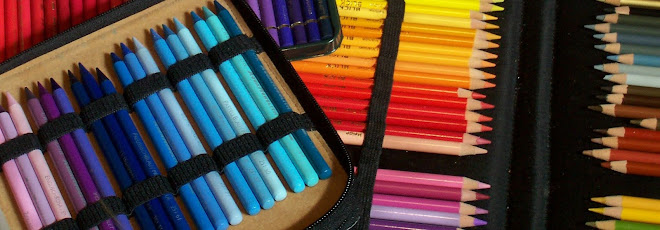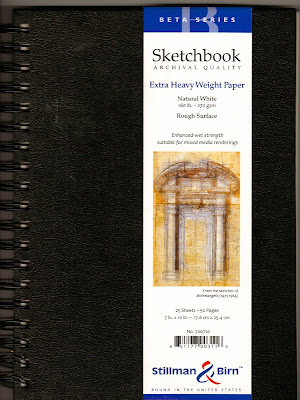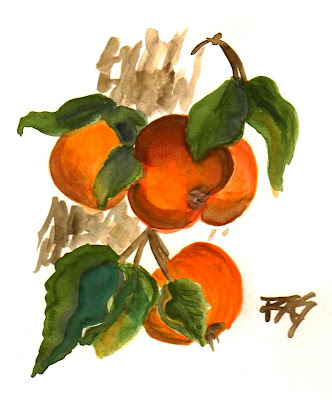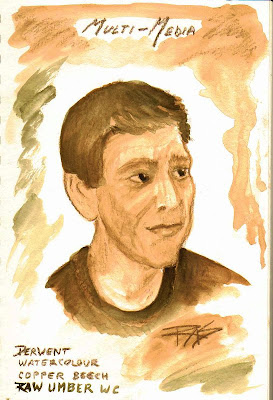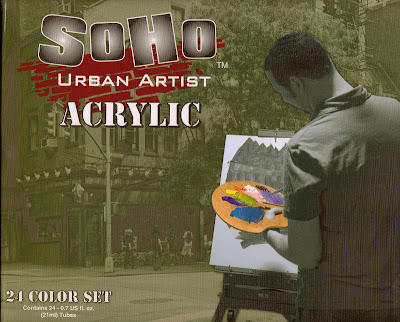
SoHo Urban Artist Acrylics are a bargain brand of heavy body acrylic paint with surprisingly good quality. Familiar pigments, consistent texture with good pigment load make these an incredible bargain at a very low price. Frugal artists, students, muralists and painters who do scenery for theatres should give these a try!
SoHo Urban Artist Acrylic paints have a good texture for heavy body acrylics. These aren’t the bottled acrylics for decorative painting, they have the texture of oils straight from the tube. Covering power is excellent on the Titanium White, though some pigments are by their nature transparent such as Dioxazine Violet.
The 24 color set provides an enormous range of choices for a new artist. The palette’s almost too generous for a beginner. Most painters will find their favorites in it. I found many of mine - Payne’s Grey, Dioxazine Violet, Sap Green, Prussian Blue as well as Pthalo Blue. My only staple pigment not represented is Permanent or Quinacridone Rose, though if I wanted a separate tube, Rose Madder is available in open stock.
Texture was the same across all colors that I used. I combined at least half of the colors in the box in my miniature, testing Yellow Ochre, Titanium White, Permanent Green Light, Sap Green, Alizarin Crimson, Dioxazine Violet, Raw Sienna, Burnt Sienna, Cadmium Yellow Hue, Lemon Yellow
Toxic pigments such as Cobalt and Cadmium are represented by Hues. Pigments aren’t listed by pigment number, but all the colors are available in open stock as well as the sets. Lightfastness is not listed on the tubes. It may be able to be derived by looking up the pigments. If you’re looking for an inexpensive acrylic paint to practice or do preliminary works, the price is right and the quality is good for student grade.
After I painted the red apple with Alizarin Crimson and Cadmium Yellow Hue, I recognized that this isn’t the fugitive traditional Alizarin Crimson that’s transparent, nearly black in mass tone and has an odd brownish undertone. It’s the brilliant, cool, purple cast Permanent Alizarin or a mixture and that bodes well for the lightfastness of the set. I’m pretty sure from the actual color of the paint that it’s more like a quinacridone and so it does superbly take the place of a Quinacridone Rose in my palette.
The price on all of the SoHo Urban Artist products is remarkably low for their quality. These acrylics are no exception, they’re comparable to Liquitex and other acrylics I’ve used. The big 24 color set is a starter with sample sized 21ml tubes. It’s a great bargain for a miniaturist especially, if you don’t use up much paint at a time they’ll likely last well or if you prefer thinning them to ink consistency for watercolor-like effects.
If you prefer working larger and bolder, all colors are also available in 75ml tubes, 250 ml big tubes and a 500ml jar. Muralists will be glad to know the regular price at Jerry’s is only $9.99 for the big 500ml jar, $3.99 for the giant 250ml tube or $2.97 for the full size 75ml tube. At time of writing they're on super sale $1.49 for the 75ml tube and the larger sizes are marked down too. Watch for sales.
The 24 color Value Set is only $19.99. Jerry's also carries a complete painting set with walnut finish table easel, 5-pack of painting boards, brushes, palette knives, 24 tubes, gloss and matte mediums plus an instructional DVD for $79.99. That one might make a great gift for a friend or relative who's interested in taking up painting. Non toxic hues and water cleanup mean the set's safe to purchase for your kids or grandkids.
Watch for sale prices if you’re planning a big project. These inexpensive good quality acrylics may be just the thing to paint large on canvases, walls, gessoed masonite or any other type of acrylic painting surface. Anyone painting flats for live theatre will be able to cut costs with those big pots.
It’s not hard to thin tube acrylics to the liquid texture of bottled acrylics for crafts projects. Just add a little water to achieve exactly the texture you want. Acrylics are the great mimic medium - you can use them for crafts like enamels, thin to transparency to use like watercolors, paint heavy bodied pictures as if they were oils and clean up or thin with water. Impasto mediums and special texture gels from Derivan and others extend the variety of effects you can get.
They dry quickly and leave little or no mess if you use a glass, ceramic or other non-porous surface. Gloss and matte mediums are available in the complete painting set but not listed separately at Jerry’s. These paints are compatible with other brands of acrylic paints and mediums, so using Liquitex, Golden or any other acrylic mediums with it should work just as well.
They dry to a very nice semi-gloss finish. If you want a gloss finish or matte finish, get some matte or gloss acrylic medium in any brand you like. Acrylic paints are compatible across brands. SoHo Urban Artist acrylics should work well with any acrylic paints you already have, whether bottled or heavy body tube paints.
A couple of tips for using SoHo Urban Artist Acrylics. Synthetic brushes are best for use with acrylics. Either use the stiff white taklon brushes that have a texture like bristle, or softer golden taklon or nylon brushes for a different look. The stiff ones will leave distinct brush strokes and painterly texture effects. Softer golden Taklon brushes can be used to smooth out all texture and hide your brush strokes for realism.
Don't use natural bristle brushes with any paint that thins with water. The flagged tips will soak water and degrade. The brush loses its stiffness and stops holding as much paint if it's soaked in water. Synthetic imitation bristle brushes stay good and firm and the hairs don't soak the water at all. They're also easier to clean if acrylic paint dries in them and cheaper to replace if ruined irreparably.
Keep your brushes damp at all times - they do dry fast and may stick in the brush hairs if you let brushes dry with paint in them. Rinse brushes in warm or hot water to soften clumps if you make a mistake and get bits of film on them, after loosening it up with Master’s Brush Cleaner cake or a gentle dish detergent. Likewise washing out a palette with warm water will make any dried paint peel up clean, while diluting and dissolving any paint that’s still wet. Don’t let large acrylic skins go down the drain or you’ll clog it though. Peel them off and chuck them in the trash.
Along with the SoHo Urban Artist Acrylics value set, I tested the SoHo Urban Artist Painting Boards that I also received to review. The surface is white, impressed with a very fine canvas pattern simulating portrait grain canvas on a sturdy 2.3mm board. They’re lightweight and didn’t warp while handling, something that can happen even with ATC size boards.
Sizes range from 12” x 16” to 2 1/2” x 3 1/2” ATC boards through several other common sizes including 11” x 14”, 9” x 12”, 6” x 9” and 8” x 10”. They’re sold in packs of five or bulk boxes of 120, 240 or 360. They’re inexpensive and convenient for a prolific painter, good for color studies, practice, display or framing. Prices range from $1.81 for the five-pack of 6” x 9” to $6.35 for the 12” x 16” so these are very inexpensive even in relation to canvas boards.
If they’re framed, it wouldn’t matter that the sides of the painting panels aren’t wrapped. It’s a small thing that bothers me a little about them but this is definitely a bargain product.
For studies, practice and frugal painters, they’ve got a good surface that takes the paint exactly as well as gessoed canvas boards. For ATCs, I might want to run a black or gilded marker around the thick sides to give the edges a nicer look. Testing that with a gold Sharpie, it didn’t take very well but using deep gold metallic gouache worked great. A bottle of metallic gold acrylic would work just as well.
If you want to paint a lot, the combination of SoHo Urban Artist Acrylics and SoHo Urban Artist Painting Boards is a good way to practice without spending a fortune. If you have big projects in mind, they may be a cost effective solution for murals, theatre sets and other very large works. Any frugal painter will have a good time with these products.
Don’t be afraid to botch anything you do with these acrylics because at this price, you can just redo it again and jot the date on the back to record your progress. Because lightfastness isn’t listed for the paints and acid free or archival isn’t listed for the boards, I’d recommend them for preliminary work, decorative work, illustration, practice, leisure painters and students.
Art journals are another excellent use for SoHo Urban Artist Acrylics. Any interior paintings aren’t going to get the kind of sustained light exposure as a wall painting in a sunny room. Another thing to remember is that while lightfastness isn’t listed, many times the non toxic hues are more lightfast than the traditional pigments they replace. They may have different qualities, such as cadmium hues sometimes being less opaque.
The colors mix beautifully, exactly as I expect for the listed pigments. Most of the named pigment colors are lightfast as far as I know, with the exception of Alizarin Crimson. It’s popular with painters but I prefer both the hue and the permanence of Permanent Alizarin Crimson. I was very glad this company's Alizarin Crimson is the modern pigment rather than the historic one.
What I’ve found as a serious painter is that being able to create color studies and preliminary versions of my paintings improves them dramatically. With art supplies, you get what you pay for. There is a reason to pay more for specialty artist grade acrylics with well known brands. Do you really want to spend that much to paint a stage set or a mural in your child’s bedroom? SoHo Urban Artist acrylics are good value for a very low price, enough to let any painter have uninhibited freedom to experiment. The best prices are on the 24 color Value Set and the biggest jars.
One last point. Sometimes even though for years I’ve been purchasing top quality artist grade supplies, I’ll freeze up and hesitate to use them or constrain myself to subjects and techniques I’m already confident with. These handle with the same consistency as other brands of heavy body acrylics, even the most expensive ones I own. When I want to cut loose and try something loony or fool around in my art journals, I’ll definitely reach for SoHo Urban Artist Acrylics. They’re priced for any budget and handle like the best.
It’s the same thing with the boards. Bulk boxes of SoHo Urban Artist Painting Boards means no need to scrape or paint over any failed experiments. Just date it, set it aside, try again and keep the series to appreciate your progress over time. There’s a lot to be said for bulk quantity in budget supplies to stimulate creativity. If you want to become a better painter, get a bulk box of boards in your favorite size. You’ll never hesitate to practice or experiment with that many chances to get it right.
Here's my example painting using SoHo Urban Artist Acrylics on an ATC size SoHo Urban Artist Painting Board. I worked from a photo of some fruit I took months ago back in Arkansas and cropped tonight to create a new ACEO.

Still Life with Violet Curtain by Robert A. Sloan.
